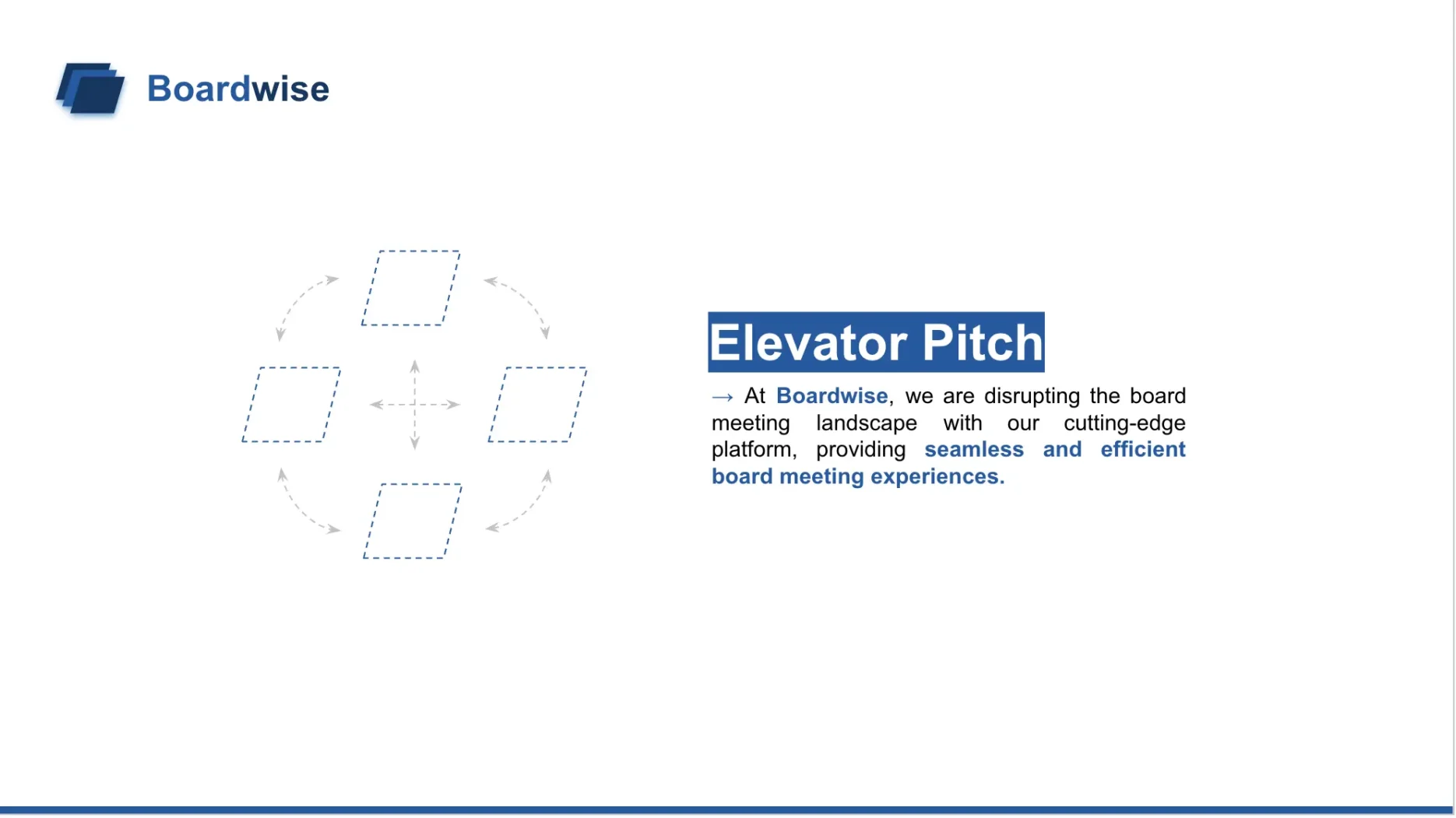
Running board meetings can be intimidating. In front of investors or potential stakeholders, explaining your decisions and projections can make you break a sweat.
That’s because board meetings provide an opportunity for important decision-makers to get together, discuss strategy, and guide the business toward success. They are important organizational milestones. However, these sessions may become disorganized, drawn out, and unclear without a properly organized and informative board deck.
A board deck serves as the foundation of an effective board meeting by giving directors a concise and thorough summary of crucial information that keeps them informed and involved.
With a strategic blend of pertinent data, visually appealing graphics, and succinct summaries, a board deck becomes an invaluable tool for effective communication and decision-making. So, this article will dive into the essential components that should be included in your board deck. And that will lead you to success.
Key Elements You Don’t Want to Miss on Your Board Deck
The board’s goal is to help companies achieve their goals. And when it comes to crafting a board deck that captures the attention of your board members, certain key elements must not be overlooked. These elements are the building blocks that ensure your board deck effectively communicates crucial information. It facilitates informed decision-making and fosters strategic alignment.
And if you’re feeling extra stressed when these meetings come around, there are resources for you to use and get inspired from.
Our team, as part of our standard business analysis, have prepared a downloadable deck that provides an in-depth examination of Boardwise’s competitive advantage, essential features, market potential, and more.
Keep on reading, and we will explore the essential components that you simply cannot afford to miss when creating your board deck. By understanding and incorporating these key elements, you will elevate the impact of your board meetings, empower your board members, and propel your organization toward its goals.
So, let’s delve into the vital ingredients that will make your board deck a powerful tool for driving progress, inspiring collaboration, and achieving success.
Board Meeting Deck: Competitive Advantage Slide
In order to differentiate yourself and gain a competitive edge in the market, it is crucial to highlight what makes your organization unique. When creating your board meeting deck, focus on the following strategies to effectively showcase your competitive advantage.
Clearly define your value proposition by succinctly conveying the core value your organization offers to customers.
Whether it’s proprietary technology, specialized expertise, or exceptional customer service, showcase these distinctive advantages. Illustrate how they contribute to your organization’s success and why customers should choose you.
However, it’s important to highlight a few key aspects and emphasize their significance; a lengthy list of distinctive advantages can potentially divert your audience’s attention from what truly matters.
An extensive list may give the impression of exaggeration or untruthfulness. Thus, it is crucial to maintain focus on the essential points that demonstrate the importance of these advantages.
Board Meeting Deck: Market Opportunities Slide
Knowing our market provides us with valuable insights into customer preferences, needs, and pain points. By thoroughly understanding their motivations and behaviors, we can tailor our products, services, and marketing efforts to meet their specific requirements.
Knowing your market is a clear indication that you have done your homework and thoroughly researched the business landscape. This slide emphasizes the significance of market understanding as a testament to your diligence and preparation.
Board Meeting Deck: Team and Organization Slide
Spend dedicated time discussing your organizational chart and outlining your hiring plans. A crucial area where boards can provide valuable support is in the recruitment and acquisition of key talent. Maximizing the effectiveness of this section is vital for your organization’s success.
Start by sharing an up-to-date organizational chart, enabling investors and board members to grasp the current structure of your workforce. Building upon this foundation, highlight the teams that require additional talent and provide a comprehensive overview of the specific roles you are actively seeking to fill. It is highly recommended to be precise and prescriptive in describing the desired skill sets and qualifications.
This approach will empower board members to leverage their networks and help identify potential candidates who align with your company’s needs. By capitalizing on their expertise, we can enhance our recruitment efforts and secure top-tier talent to drive our organization forward.
Board Meeting Deck: Sales Projections Slide
The Sales Projections slide provides a comprehensive overview of your organization’s anticipated sales growth and revenue potential. This slide showcases your forward-thinking approach, demonstrating our ability to forecast future performance and align our strategies accordingly. By presenting these projections, you aim to provide the board with a clear understanding of your sales targets and potential financial outcomes.
The Sales Projections Slide provides a framework for evaluating the effectiveness of your current sales initiatives and identifying areas of improvement. By outlining key strategies, such as market expansion, customer acquisition, and upselling, you can showcase your comprehensive approach to driving sales growth.
Tips to Ace Your Board Meeting Deck
After putting in all the hard work to create a compelling board meeting deck, it’s crucial to prepare yourself to deliver a stellar presentation. One essential tip is to rehearse your presentation multiple times.
Practice not only helps you become familiar with the content, but it also improves your delivery and confidence. By rehearsing, you can fine-tune your timing, ensure a smooth flow between slides, and anticipate potential questions or challenges that may arise during the meeting.
Also, consider incorporating storytelling techniques into your presentation. Humans are wired to respond to stories, so weaving a compelling narrative throughout your board meeting deck can capture the attention and imagination of the audience.
Keep it Simple
It’s essential to keep the deck concise and focused.
Board members often have limited time and attention spans, so it’s crucial to present the information in a clear and straightforward manner. Keep the number of slides to a minimum, and ensure that each slide has a specific purpose, whether it’s providing data, outlining key points, or presenting recommendations.
Audience Analysis & Clear Objectives
Before starting your board meeting deck, clearly define the objectives you want to achieve. Determine the key messages you want to convey and the specific outcomes you aim to accomplish. This will help you structure your content in a concise and focused manner, ensuring that every slide serves a purpose and contributes to your overall goal. This leads us to the next point…
Relevant Information
Make sure to highlight the most critical information upfront. Board members are typically interested in key metrics, financial performance, and strategic initiatives. Start the deck with a compelling executive summary that captures their attention and provides an overview of the main takeaways.
By doing so, you set the tone for the rest of the presentation and ensure that board members grasp the key points from the beginning.
Visual Presentation
In addition to the content and delivery, the visual aspect of your board meeting deck plays a crucial role in making a strong impression. When it comes to visuals, simplicity and clarity should be your guiding principles.
Use a clean and consistent design that aligns with your company’s branding, and choose fonts, colors, and graphics that enhance readability and comprehension. Avoid overcrowding slides with excessive text, and instead, use concise bullet points or key phrases to convey your message. Supplement your content with relevant and impactful visuals such as charts, graphs, and images to illustrate data, trends, or ideas effectively.
Remember, visual aids should support and enhance your presentation, not overshadow or distract from it.
Board Meeting Deck Template: Final Thoughts
To ace your board meeting deck, focus on the following key points: keeping it concise and focused, highlighting critical information upfront, rehearsing your presentation, understanding your audience, incorporating storytelling techniques, and creating visually appealing slides. Stay confident, engage with board members, and be prepared to address any questions or concerns. With thorough preparation and a well-crafted deck, you’ll impress your audience and achieve your objectives.





